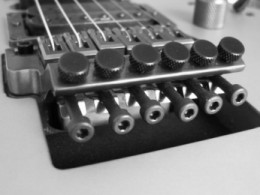The intonation / scale length refers to the distance between your nut and the point of first contact between your string and your bridge.
Have you ever found that you tune a guitar perfectly but the higher frets don’t play at the pitch they should? That could be caused by incorrect scale length, although it could also be potentially due to a high action.
The frets on a neck have been designed to a specific scale length. Therefore if the scale length isn’t correctly set, the frets won’t sound the string at the correct pitch. This is more apparent higher up the neck, e.g. the 17th fret.
Checking if the Scale Length is Correct
The scale length should ideally be set so that the 12th fret lies perfectly under the centre of the string. A crude way checking this is by playing the 2nd harmonic, i.e. touch your finger on the 12th fret and pick it. See the lesson on harmonics if you don’t understand what I mean.
Once you play the 2nd harmonic, compare it to the pitch of the string when playing the 12th fret. If these differ, you probably have incorrect scale length. This should normally be done using an electronic tuner to ensure accuracy.
The other way of checking it, which is more accurate, is to actually physically measure your scale length and see where the 12th fret lies in respect to the scale length of your guitar.
Intonation / Scale Length Adjustment
The scale length of a particular string can be adjusted from the bridge.

Scale length adjustment
If you’re adjusting a bridge that’s like this one or a Strat (which is very similar), there are usually screws behind the bridge which can be tightened to increase (or loosened to decrease) the scale length.
When adjusting the scale length, you should make sure you loosen the strings to relieve these screws of any tension to make sure they don’t get damaged in the process. Also you should keep in mind that if you loosens the screws too much it is possible that part of the bridge called saddles (the metallic blocks) will become detached.
As a general guide:
- If the 2nd harmonic is flat compared to the 12th fret, the scale length of that string needs to be increased by tightening the screw.
- If the 2nd harmonic is sharp compared to the 12th fret, the scale length of that string needs to be decreased by loosening the screw.
Adjustment – Floyd Rose Bridge
The intonation / scale length is adjusted in a slightly different way on a Floyd Rose bridge.

Floyd Rose bridge – saddle lock
On a Floyd Rose, each of the saddles are in fact locked down by 6 individual screws, called the saddle lock. These must be loosened to allow adjustment of the saddles.

Floyd Rose bridge – rods
Once this has been done, the saddles can be moved back and forth using these rods at the back of the bridge. These shouldn’t be turned as this will release the strings from the bridge.
The actual adjustment of intonation is done in a similar way as before:
- If the 2nd harmonic is flat compared to the 12th fret, the scale length of that string needs to be increased by slightly pulling the rod out of the bridge.
- If the 2nd harmonic is sharp compared to the 12th fret, the scale length of that string needs to be decreased by slightly pushing the rod into the bridge.
- Want to improve your guitar playing?
-
These lessons have been written by me, a guitar enthuthiast. I've written them to the best of my abilities, but I'm no guitar teacher!
If you want award-winning, well structured but inexpensive lessons, I strongly recommend you check out Guitar Tricks. They have great range of video guitar lessons from numerous coaches specialising in a wide range of styles.
I've seen their videos, and they're great. With these guys, I'm confident you'll be improving in no time!
